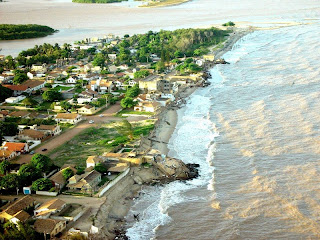Florida: Rising Sea Level Floods Road to National Park
J. Earle Bowden Way is a 7-mile long two lane ribbon of roadway that threads it's way through pristine sand dunes and remnants of British and Spanish forts from as early as 1763. The park also features Civil War structures and gun placements from WWII. The road is the only access by land to the beautiful and historic area known as Fort Pickens, a part of the Gulf Islands National Seashore park system.
I believe climate change is fundamentally the greatest threat to the integrity of our national parks that we have ever experienced. The current science confirms the planet is warming and the effects are here and now.
Jonathan B. Jarvis, Director, National Park Service, August 2010

Since August, the road that hugs the Gulf of Mexico has been closed four times to remove sand and repair storm damage.No longer does it take a hurricane to wash out portions of the road. A strong south wind combined with high tide can send waves surging over the road and deposit sand drifts that can be 6 inches high.“That’s the new normal,” Gulf Islands National Seashore Superintendent Dan Brown said. “We are going to lose that section of the road, in all likelihood, sooner rather than later. I don’t know if it’s going to be six months, six years or 10 years from now.” Pensacola News Journal

No, that is not snow in Florida, that is the sugar white sand of the Florida Panhandle. The dark matter seen in several scenes is asphalt that has broken off the road as a result of the flooding. In the video report, Superintendent Brown explains the problems created by climate change and what needs to be done to save access to the park.
Brown is following the recommendations of a 2010 National Park Service Climate Change Response Strategy that call for the relocation of buildings and infrastructure vulnerable to rising seas, more intense and frequent storms, and rapid coastal erosion.
Sequestration
Sequestration is a contributing factor to the maintenance (or lack of) to the road. According to the National Park Service,
"Sand removal from road shoulder bike lanes will occur less frequently and the Seashore will no longer contract sand removal after storms, relying solely on park staff and equipment to clear roads.This may result in longer road closures following storms."As of March 1, sequestration will reduce the Gulf Islands Nation Seashore FY 2013 budget by $395,000. While no workers will be furloughed, visitor centers will be closed several days a week. In addition, some restrooms will be closed and trash removal will be cut back.
Fort Pickens is visited by an estimated 5 million yearly visitors, according to the report by PNJ.
The park admission is $3.00 per person or $8.00 per vehicle. Both fees are valid for 1-7 days. Free passes are available for military and family (h/t to Michelle Obama and Jill Biden). Camping is available at the popular campgrounds for $20.00 per night per site.
The Future
While waiting for environmental, archaeological studies, and federal funding, officials are currently flagging off a new route for the road that will relocate 1.4 miles of the pavement "behind some old, large sand dunes that would protect it from being washed over by waves and sand, reducing or even eliminating frequent road closures and costly cleanups."
Between 1995 and 2012, the federal government spent more than $50 million to repair the 7-mile stretch of road through the Seashore between Pensacola Beach and Navarre Beach, and Fort Pickens Road.
“It may take two or three years to have the realignment in place, and we’re keeping our fingers crossed we don’t lose the road before then,” Brown said. “Our goal is to maintain connectivity.”It is perhaps inevitable that this section of the road will be completely and permanently inundated by the rising Gulf of Mexico, and other measures have been taken to keep the park open in the future.
A ferry landing on Pensacola Bay near the fort already has been built. And the seashore has applied for BP oil spill early restoration dollars to buy ferries to provide an alternative for visitors and employees to access the park, regardless of what happens to the road, Brown said.Local merchants and hotels are concerned of the economic impact to the tourist area that is still recovering from the BP oil spill.
http://www.dailykos.com

Comentários
Postar um comentário